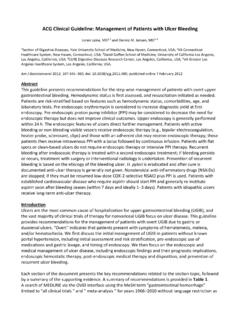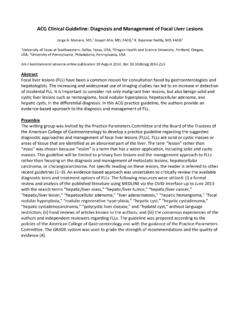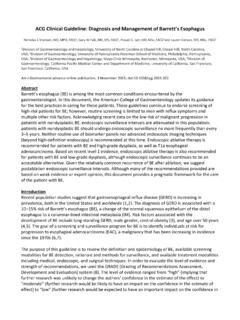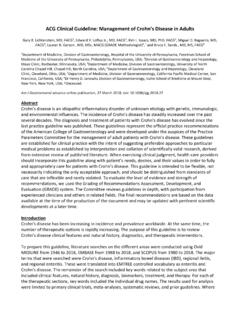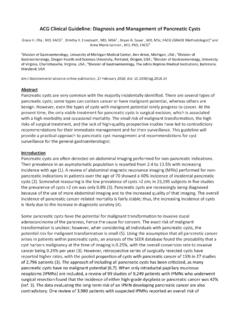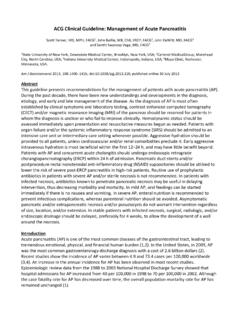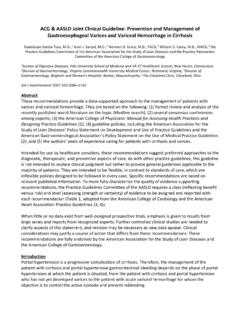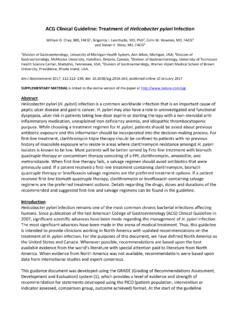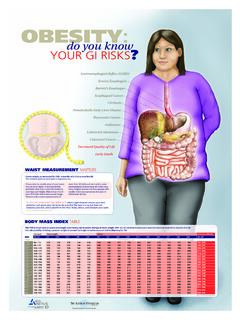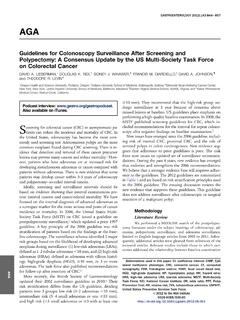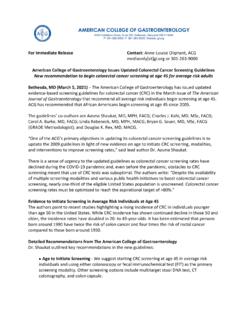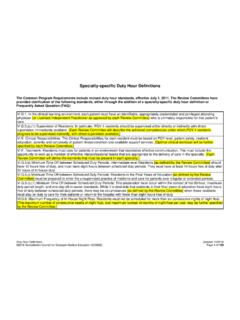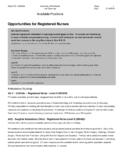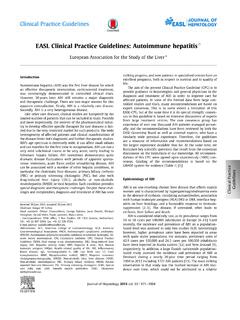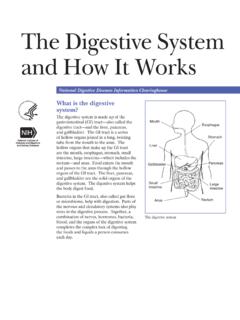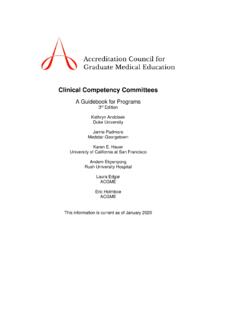Transcription of ACG Clinical Guideline: Evaluation of Abnormal Liver ...
1 ACG Clinical Guideline: Evaluation of Abnormal Liver Chemistries Paul Y. Kwo, MD, FACG, FAASLD1, Stanley M. Cohen, MD, FACG, FAASLD2, and Joseph K. Lim, MD, FACG, FAASLD3 1 Division of gastroenterology /Hepatology, Department of Medicine, Stanford University School of Medicine, Palo Alto, California, USA; 2 Digestive Health Institute, University Hospitals Cleveland Medical Center and Division of gastroenterology and Liver Disease, Department of Medicine, Case Western Reserve University School of Medicine, Cleveland, Ohio, USA; 3 Yale Viral Hepatitis Program, Yale University School of Medicine, New Haven, Connecticut, USA. Am J Gastroenterol 2017; 112:18 35; ; published online 20 December 2016 Abstract Clinicians are required to assess Abnormal Liver chemistries on a daily basis. The most common Liver chemistries ordered are serum alanine aminotransferase (ALT), aspartate aminotransferase (AST), alkaline phosphatase and bilirubin.
2 These tests should be termed Liver chemistries or Liver tests. Hepatocellular injury is defined as disproportionate elevation of AST and ALT levels compared with alkaline phosphatase levels. Cholestatic injury is defined as disproportionate elevation of alkaline phosphatase level as compared with AST and ALT levels. The majority of bilirubin circulates as unconjugated bilirubin and an elevated conjugated bilirubin implies hepatocellular disease or cholestasis. Multiple studies have demonstrated that the presence of an elevated ALT has been associated with increased Liver -related mortality. A true healthy normal ALT level ranges from 29 to 33 IU/l for males, 19 to 25 IU/l for females and levels above this should be assessed. The degree of elevation of ALT and or AST in the Clinical setting helps guide the Evaluation . The Evaluation of hepatocellular injury includes testing for viral hepatitis A, B, and C, assessment for nonalcoholic fatty Liver disease and alcoholic Liver disease, screening for hereditary hemochromatosis, autoimmune hepatitis, Wilson s disease, and alpha-1 antitrypsin deficiency.
3 In addition, a history of prescribed and over-the-counter medicines should be sought. For the Evaluation of an alkaline phosphatase elevation determined to be of hepatic origin, testing for primary biliary cholangitis and primary sclerosing cholangitis should be undertaken. Total bilirubin elevation can occur in either cholestatic or hepatocellular diseases. Elevated total serum bilirubin levels should be fractionated to direct and indirect bilirubin fractions and an elevated serum conjugated bilirubin implies hepatocellular disease or biliary obstruction in most settings. A Liver biopsy may be considered when serologic testing and imaging fails to elucidate a diagnosis, to stage a condition, or when multiple diagnoses are possible. Introduction The authors were invited by the Board of Trustees and Practice guidelines Committee of the american college of gastroenterology to develop a practice guideline regarding the Evaluation of Abnormal Liver chemistries.
4 We used the following resources: 1. A formal review and literature search of the world literature on MEDLINE and EMBASE databases dealing with the Evaluation of Abnormal Liver chemistries, studies that dealt with normal or reference range for alanine aminotransferase (ALT) levels and what thresholds trigger an Evaluation for actionable Liver disease. Studies detailing the relationship between ALT and nonalcoholic fatty Liver disease, as well as studies assessing the significance of elevated Liver chemistries on overall mortality and morbidity. 2. Guideline policies of the american college of gastroenterology . 3. The experience of the authors and independent reviewers, as well as communication with senior hepatologists across the United States with regard to the threshold for evaluating Abnormal Liver chemistries. These recommendations are intended for use by physicians and health care providers and suggest preferred approaches to the diagnoses and Evaluation of those with Abnormal Liver tests (Table 1).
5 These guidelines are intended to be flexible and should be adjusted as deemed appropriate when applied to individual patients. Recommendations are evidence-based where possible. On subjects lacking rigid scientific data, recommendations are made based on the consensus opinion of the authors. To more fully characterize the available evidence reporting the recommendations, the ACG Practice Guideline Committee has adopted the classification used by the grading of recommendation assessment, development, and Evaluation workup with modifications. The strength of recommendations are classified as strong or conditional. The quality of evidence supporting strong or weak recommendations are designated by the following level is high, moderate low, or very low quality (1). This is a practice guideline rather than a review article. Liver chemistries that are commonly ordered in comprehensive metabolic profiles are indirect markers of hepatobiliary disease.
6 They are not true measures of hepatic function and thus are best referred to as Liver chemistries or Liver tests, and should not be referred to as Liver function tests. True tests of Liver function are not commonly performed but include measurement of hepatic substrates that are cleared by hepatic uptake, metabolism, or both processes (2). Because of the widespread use of the comprehensive metabolic profile testing that is done in routine practice to screen those who present for routine Evaluation as well as those who are symptomatic and/or referred for elevation of Abnormal Liver chemistries, such abnormalities require a rational approach to interpretation. To date, there are no controlled trials that have been performed to determine the optimal approach to evaluate Abnormal Liver chemistries. This guideline has been developed to assist gastroenterologists and primary care providers in the interpretation of normal and Abnormal Liver chemistries as well as an approach to prioritize and evaluate those who present with Abnormal Liver chemistries.
7 Table 1. Recommendations 1. Before initiation of Evaluation of Abnormal Liver chemistries, one should repeat the lab panel and/or perform a clarifying test ( , GGT if serum alkaline phosphate is elevated) to confirm that the Liver chemistry is actually Abnormal . (Strong recommendation, very low level of evidence). 2. Testing for chronic hepatitis C is conducted with anti-HCV and confirmation is performed with HCV-RNA by nucleic acid testing. Risk factors for hepatitis C include history of intranasal or intravenous drug use, tattoos, body piercings, blood transfusions, high risk sexual conduct, and those born between 1945 and 1965. Testing for acute hepatitis C is with anti-HCV and HCV RNA by nucleic acid testing. (Strong recommendation, very low level of evidence). 3. Testing for chronic hepatitis B is conducted with HBsAg testing. Testing for acute hepatitis B is with HBsAg and IgM anti-HBc. The following groups are at highest risk: persons born in endemic or hyperendemic areas (HBsAg prevalence >2%), men who have sex with men, persons who have ever used injection drugs, dialysis patients, HIV-infected individuals, pregnant women, and family members, household members, and sexual contacts of HBV-infected persons.
8 (Strong recommendation, very low level of evidence). 4. Testing for acute Hepatitis A (IgM HAV) should occur in patients presenting with acute hepatitis and possible fecal-oral exposure. Testing for acute hepatitis E (IgM HEV) should also be considered in those returning from endemic areas and whose tests for acute hepatitis A, B, and C are negative. (Strong recommendation, very low level of evidence). 5. Patients with elevated BMI and other features of metabolic syndrome including diabetes mellitus, overweight or obesity, hyperlipidemia, or hypertension with mild elevations of ALT should undergo screening for NAFLD with ultrasound. (Strong recommendation, very low level of evidence). 6. Women consuming more than 140 g per week or men consuming more than 210 g per week who present with AST>ALT should be considered at risk for alcoholic Liver disease and should be counseled for alcohol cessation. (Strong recommendation, very low level of evidence).
9 7. All patients with Abnormal Liver chemistries in the absence of acute hepatitis should undergo testing for hereditary hemochromatosis with an iron level, transferrin saturation, and serum ferritin. HFE gene mutation analysis should be performed in patients with transferrin saturation 45% and/or elevated serum ferritin. (Strong recommendation, very low level of evidence). 8. Patients with Abnormal AST and ALT levels, particularly patients with other autoimmune conditions, should undergo testing for autoimmune Liver disease including ANA, ASMA, and globulin level. (Strong recommendation, very low level of evidence). 9. Patients with persistently elevated AST and ALT levels, especially patients <55 years of age, should undergo screening for Wilson s disease with serum ceruloplasmin testing. In the setting of low ceruloplasmin, confirmatory testing with 24-h urinary copper and slit-lamp eye examination to identify pathognomonic Kayser Fleischer rings should occur.
10 (Strong recommendation, very low level of evidence). 10. Patients with persistently elevated AST or ALT should undergo screening for alpha-1 anti-trypsin (A1AT) deficiency with alpha-1 anti-trypsin phenotype. (Strong recommendation, very low level of evidence). 11. Physicians should ask patients with Abnormal Liver chemistries about prescribed and over-the-counter medications, non-prescribed complementary or alternative medicines, and dietary or herbal supplements which may be associated with DILI. (Strong recommendation, very low level of evidence). 12. A Liver biopsy may be considered when serologic testing and imaging fails to elucidate a diagnosis, to stage a condition, or when multiple diagnoses are possible. (Strong recommendation, very low level of evidence). 13. An elevation of alkaline phosphatase should be confirmed with an elevation in GGT. Given its lack of specificity for Liver disease, GGT should not be used as a screening test for underlying Liver disease in the absence of other Abnormal Liver chemistries.
